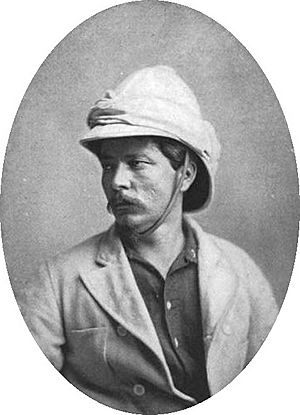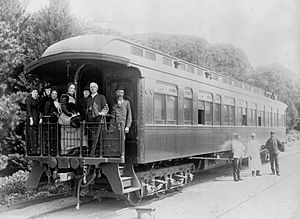Henry Morton Stanley facts for kids
Quick facts for kids
Sir Henry Morton Stanley
|
|
|---|---|

Journalist and explorer
|
|
| Born |
John Rowlands
28 January 1841 |
| Died | 10 May 1904 (aged 63) |
| Awards | Vega Medal (1883) |
| Signature | |
Sir Henry Morton Stanley GCB (born John Rowlands; 28 January 1841 – 10 May 1904) was a Welsh journalist and explorer. He was famous for his exploration of central Africa, and his search for missionary and explorer David Livingstone.
When he found Livingstone, Stanley reportedly asked, "Dr. Livingstone, I presume?" Stanley is also known for his search for the source of the Nile, his work in the Congo Basin, and for commanding the Emin Pasha Relief Expedition.
Stanley's expeditions are known for cruelty to Africans. Despite this, he was highly admired and supported by British and Belgian monarchies and knighted in 1899.
Stanley was a Member of parliament for Lambeth North from 1895-1900.
Contents
Early life
Stanley never knew his father, and was abandoned by his mother after birth. He carried this emotional trauma all his life.
The boy brought up by his grandfather Moses Parry, a once-prosperous butcher who was living in reduced circumstances. He cared for the boy until he died, when John was five. Stanley stayed with families of cousins and nieces for a short time, but he was eventually sent to the St. Asaph Union Workhouse for the Poor. The overcrowding and lack of supervision resulted in his being frequently abused by older boys.
Rowlands emigrated to the United States in 1859 at age 18. Following the American Civil War, Stanley became a journalist in the days of frontier expansion in the American West. n 1870, Stanley undertook several assignments for the Herald in the Middle East and the Black Sea region, visiting Egypt, Jerusalem, Constantinople, the Crimea, the Caucasus, Persia and India.
Finding Livingstone
In 1869, Stanley was instructed by the New York Herald to find the Scottish missionary and explorer David Livingstone, who was known to be in Africa but had not been heard from for some time. According to Stanley's account, he asked how much he could spend. The reply was "Draw £1,000 now, and when you have gone through that, draw another £1,000, and when that is spent, draw another £1,000, and when you have finished that, draw another £1,000, and so on — BUT FIND LIVINGSTONE!" Stanley had lobbied his employer for several years to mount this expedition.
Stanley found Livingstone on 10 November 1871, in Ujiji near Lake Tanganyika in present-day Tanzania. He may have greeted him with the now-famous line, "Doctor Livingstone, I presume?" It may also have been a fabrication, as Stanley tore out of his diary the pages relating to the encounter.
Researching the Congo River
In 1874, the New York Herald, in partnership with Britain's Daily Telegraph, financed Stanley on another expedition to the African continent. One of his missions was to solve a last great mystery of Africa by tracing the course of the Congo River to the sea. The difficulty of this expedition is hard to overstate. Stanley used sectional boats to pass the great cataracts that separated the Congo into distinct tracts. The boats had to be taken apart and transported around the rapids before being rebuilt to travel on the next section of river. After 999 days, on 9 August 1877, Stanley reached the Portuguese outpost of Boma, around 100 km from the mouth of the Congo River. Starting with 356 people, he reached Boma with 114 survivors, and he was the only European left. He wrote about his trials in his book Through the Dark Continent.
Claiming the Congo for the Belgian king
Stanley was approached by King Leopold II of the Belgians, the ambitious Belgian monarch. In 1876 the king organized a private holding company disguised as an international scientific and philanthropic (goodwill) association. He called it the International African Association.
The King spoke of his intentions to introduce Western civilization and bring religion to that part of Africa. He did not mention he wanted to claim the lands. At the end of his life, the King was embittered that his establishment of a Congo Free State was spoilt by its unscrupulous government. Also, the spread of sleeping sickness across central Africa may have been caused by the movements of Stanley's enormous baggage train, and the Emin Pasha relief expedition.
Emin Pasha Relief Expedition
In 1886, Stanley led the Emin Pasha Relief Expedition to "rescue" Emin Pasha, the governor of Equatoria in the southern Sudan. King Leopold II demanded that Stanley take the longer route, via the Congo River. He hoped to get more territory. After immense hardships and great loss of life, Stanley met Emin in 1888, charted the Ruwenzori Range and Lake Edward, and emerged from the interior with Emin and his surviving followers at the end of 1890.
This expedition tarnished Stanley's name because of the conduct of the other Europeans: British gentlemen and army officers.
Later years

On his return to Europe, Stanley married English artist Dorothy Tennant. They adopted a child named Denzil, who was the son of one of Stanley's first cousins, though Stanley concealed this fact from the public and possibly even from Dorothy. Denzil later donated around 300 items to the Stanley archives at the Royal Museum of Central Africa in Tervuren, Belgium in 1954. He died in 1959.
Mainly at his wife's behest, Stanley entered Parliament as a Liberal Unionist member for Lambeth North, serving from 1895 to 1900. He disliked politics and made little impression on Parliament. He became Sir Henry Morton Stanley when he was made a Knight Grand Cross of the Order of the Bath in the 1899 Birthday Honours, in recognition of his service to the British Empire in Africa. In 1890, he was given the Grand Cordon of the Order of Leopold by King Leopold II.
Stanley died at his home at 2 Richmond Terrace, Whitehall, London on 10 May 1904. At his funeral, he was eulogised by Daniel P. Virmar.
His grave is in the churchyard of St Michael and All Angels' Church in Pirbright, Surrey, marked by a large piece of granite inscribed with the words "Henry Morton Stanley, Bula Matari, 1841–1904, Africa". Bula Matari translates as "Breaker of Rocks" or "Breakstones" in Kongo and was Stanley's name among locals in Congo. It can be translated as a term of endearment for, as the leader of Leopold's expedition, he commonly worked with the labourers breaking rocks with which they built the first modern road along the Congo River. Author Adam Hochschild suggested that Stanley understood it as a heroic epithet, but there is evidence that Nsakala, the man who coined it, had meant it humorously.
Works by Stanley
- Stanley, Henry Morton (1872). How I Found Livingstone: Travels, Adventures and Discoveries in Central Africa: Including an Account of Four Months' Residence with Dr. Livingstone. Scribner, Armstrong & Company. ISBN 9780524087862.
- Stanley, Henry Morton (1878). Through the Dark Continent; Or, The Sources of the Nile: Around the Great Lakes of Equatorial Africa and Down the Livingstone River to the Atlantic Ocean. Sampson Low, Marston, Searle, Rivington.
- Stanley, Henry Morton (1885). The Congo and the Founding of Its Free State: A Story of Work and Exploration. Harper & Brothers. ISBN 9780403002887.
- Stanley, Henry Morton (1890). In Darkest Africa; Or, The Quest, Rescue, and Retreat of Emin, Governor of Equatoria. Scribner.
- Stanley, Henry (1893). Slavery and the slave trade in Africa. New York: Harper & brothers.
- Stanley, Henry Morton (1909). The Autobiography of Sir Henry Morton Stanley .... Houghton Mifflin. ISBN 9780837119632.
- Stanley, Henry Morton (1961). Stanley, Richard; Neame, Alan. eds. The Exploration Diaries: Of H. M. Stanley. Now First Published from the Original Manuscripts. Kimber.
- Stanley, Henry Morton (1970). Bennett, Norman Robert. ed. Stanley's Despatches to the New York Herald: 1871–1872, 1874–1877. Boston University Press. ISBN 978-0-8419-8706-7.
Image
-
Stanley's graffito at Persepolis, Iran
-
1872 Carte de visite – Stanley and Kalulu.
-
Henry Stanley and party standing on the back of an observation car at Monterey, California, 19 March 1891
-
Henry Morton Stanley's grave in Pirbright, Surrey
-
Memorial to H. M. Stanley in St Asaph
See also
 In Spanish: Henry Morton Stanley para niños
In Spanish: Henry Morton Stanley para niños













